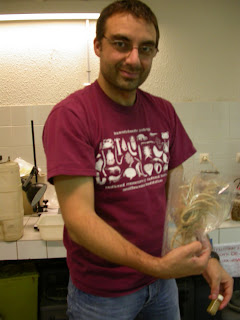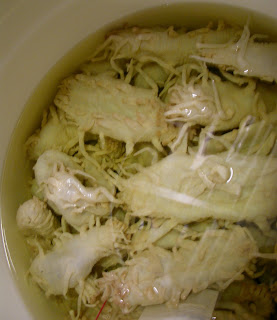GREETINGS!! and Happy Pre-Emptive End of the Year to all of you!
I have been sitting back after a good year of research and echinoblogging-and honestly, I was going to give you guys some videos and "best of" stuff for this holiday season, but I found something that I thought all of you might appreciate instead!
So, the good people over at National Geographic have a truly beautiful website with stunning images deserving of such a widely read and respected magazine.
I found that they had this delightful gallery of "sea stars" (click here).
Alas, there were some..inaccuracies and points that I thought a person with my particular eye might be able to contribute to their photo gallery (which regrettably lacks a comments section).
And so, what I present to you herein is a collection of THEIR pictures but with my added commentary and/or factoids/links that help to embellish their very fine figures!!
So, before I begin-I do recognize that a lot of these are just various starfish factoids applied liberally to give each picture a story...but y'know what? I can do these animals a bit more justice and so I will...
1. Pycnopodia helianthoides-the sunflower star (Asteriidae)
For the most part, the narrative for this image was correct, but I had to take some umbrage with the statement "only the five rayed species really resemble stars-others may boast as many as 40 appendages".
BUT, While most five rayed species are "stellate", not everything with five rays "resemble stars". Take for example:
This blog post featuring fossil Sphaeraster and LIVING Podosphaeraster (click).
This blog featuring the deep-sea asteroid-Tremaster mirabilis (click)
The tropical reef "cushion star" Culcita novaeguinae (click)
..and of course the holiday favorite-the cookie shaped Goniasteridae! (click)
and by the way...multi-rayed individuals can get up to 50 arms! (we'll see that below).
2. Fromia indica (Goniasteridae)
The original accompanying text calls this surface of this species "the backside".
hmm.
The bottom-also called- the oral surface- is where the mouth is located.
As a consequence, the opposite or upper side is called the aboral surface. In general, sea stars lack a "back" since there's no backbone.
Calling a starfish abactinal surface a "backside" is kind of like saying humans don't have enough ambulacral ossicles. It really doesn't make any sense.
The narrative also mentions this:
This star boasts a full complement of five arms but it may not always keep them. When grabbed by a predator, the sea star can simply lose a limb and later grow a replacement. In fact, some species can grow a new body from just a single severed limb and a small part of their central disk.Parts of this are true for Fromia, which have a basic ability to regenerate arms.
But I'm not sure that cutting or damaging a starfish like Fromia to the extent that you have only an arm fragment+disk would result into a new animal.
Its true, that some species such as Linckia multifora or Asterias spp. can regrow a body from a chunk of the disk+arm. But from what I've seen, cutting something like this Fromia into two pieces-would most likely result in getting two halves of a dead Fromia!
3. OPHIUROIDS (aka Basket/Serpent/Brittle Stars) ARE NOT SEA STARS/STARFISH!!!
The following hits at two pictures described as "sea stars" in the National Geographic gallery...
So, as a person who studies and classifies animals for a living, I CAN assure you, this sort of thing is important! Asteroids and ophiuroids are two ENTIRELY separate animals that have been evolutionarily separated from one another LONGER than humans have EXISTED. So, please give them some respect!
What's the difference between asteroids (starfish or sea stars) Versus ophiuroids (basket stars and brittle stars)???
Take this post I wrote about structural differences for starters...
3a. Gorgonocephalus! okay? Now, THIS (original post here) ? is a member of the Class Ophiuroidea. It is a "basket star", a member of a whole family within the Ophiuroidea. Specifically, the genus Gorgonocephalus...
AND by the way...do ya' wanna know more about these weird basket star things??
HERE is a post I wrote about them!
3b. Tiny Brittle Star & some stuff on Brittle Stars! Now, the pic on this tiny thing isn't enough to clearly tell even which family it is (looks like either a member of the Ophiothricidae or the Amphiuridae though..). Note that this tiny little brittle star? is itself sitting on a much larger starfish called Euretaster (not sure which species but you can see one example here in all of its glory!)
 The narrative on this pic reads
The narrative on this pic readsSome 2,000 sea star species live throughout the world’s oceans. Some weigh as much as 11 pounds (5 kilograms) and stretch more than 2 feet (65 centimeters) across, but others are only half an inch (1 centimeter) in diameter. These animals reproduce prolifically, and some sea stars can release millions of eggs into the water for fertilization at the same time.Now, if this were actually an asteroid (i.e. a sea star or starfish) this would be true. But the pic seems focused on the little tiny brittle star (ophiuroid).
Again- ophiuroids (including brittle stars and basket stars) is a member of a separate CLASS. A completely DIFFERENT group of animals that not only is VERY structurally different (again see here).. But one that has been evolutionarily separated from sea stars since the Paleozoic (for at LEAST 250 million years ago if not older). Ophiuroids are quite diverse on their own..and are probably the MOST numerous of all the living echinoderms! Asteroids number about 1800 maybe 1900 species. The number of ophiuroid species STARTS at about 2000 with MORE being discovered regularly!
Bottom line: Asteroids and Ophiuroids are NOT THE SAME THING. And should not be "lumped together" under the same common name.
Please make a note of it!
4. Pisaster giganteus (Asteriidae).What's going on Here? Probably SEX!
I think this is an unobserved reproductive stance! Go HERE to read about other species and their sexy starfish love positions!!
I honestly, don't know if this position has been recorded from Pisaster giganteus before! See what you miss if you don't know what you're looking at???
5. Labidiaster annulatus (Heliasteridae)
This is actually a pretty cool and novel image! I don't know that ANYONE has ever observed Labidiaster feeding on a BIRD before!
Ha! take that vertebrates!
 Personally, I'm not sure calling these "sun stars" as a common name is either accurate or particularly original. Especially given that at least 3 other species in different families have been called "sun stars".
Personally, I'm not sure calling these "sun stars" as a common name is either accurate or particularly original. Especially given that at least 3 other species in different families have been called "sun stars".Labidiaster in the Antarctic are VERY specialized benthopelagic predators! Go here to read the full account!
6. Tosia neossia (Goniasteridae)
 (photo by Jason Edwards, National Geographic)
(photo by Jason Edwards, National Geographic)
Based on the colors and some of the other characters, this looked more to me like the brooding than the non-brooding species...
There is a GREAT story about cryptic species surrounding these Australian "biscuit stars"-Tosia australis and a new species Tosia neossia!! Go HERE to see it!
There is a GREAT story about cryptic species surrounding these Australian "biscuit stars"-Tosia australis and a new species Tosia neossia!! Go HERE to see it!
7. Oreaster reticulatus (Oreasteridae)
The narrative that goes along with this picture is correct in many general ways-asteroids are important in marine ecosystems, and they note "....including keeping populatinos of shellfish in check.."
Now, they may have simply been speaking in generalities again-but just to be clear-this species-Oreaster reticulatus? Does not feed on shellfish!
The known diet for most oreasterids-including Protoreaster nodosus (the so-called chocolate chip star known to the pet and tourist trade) and Oreaster reticulatus suggests that they feed on encrusting animals, such as sponges in addition to microalgal film and fine organic particles from the surrounding sediment and nearby bottoms.
Don't believe me? Go here and see this. This. And this.
8. Acanthaster planci (Acanthasteridae)
The original story with this pic had a line that read "Scientists aren't sure exactly what causes such outbreaks, or what their ultimate impacts may be on coral reef health".
Hm. I think I can do a little better than that...
New research suggests that the plague-level outbreaks of this species are tied to a surge in nutrients. Read a blog about this here.
To be sure, there are always uncertainties around "big ideas" that explain natural phenomena such as huge population outbreaks..so who knows? Perhaps new explanations will present themselves in the years to come...















 And finally..the ever-busy
And finally..the ever-busy 

































